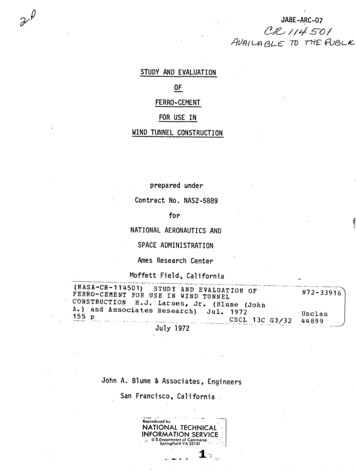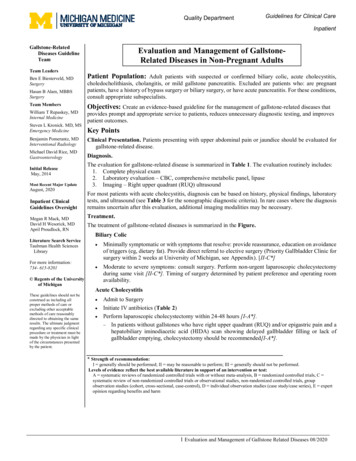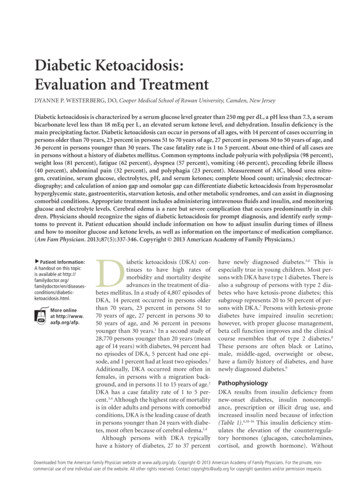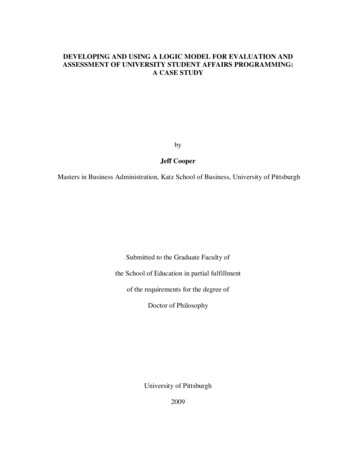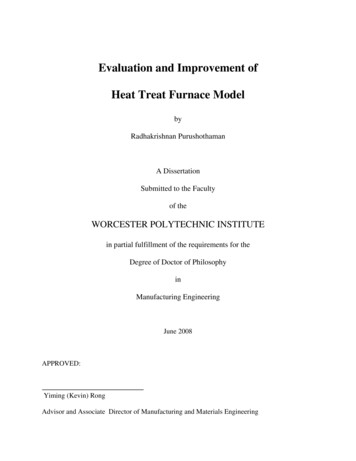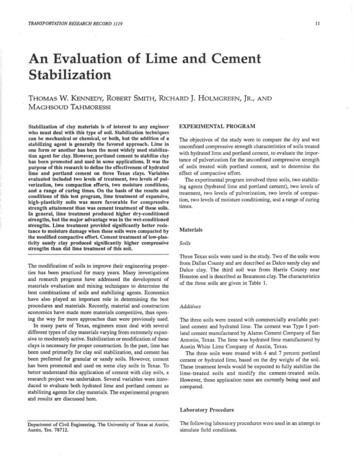
Transcription
11TRANSPORTATION RESEARCH RECORD 1119An Evaluation of Lime and CementStabilizationTHOMASW.KENNEDY, ROBERT SMITH, RICHARD J. HOLMGREEN, JR., ANDMAGHSOUD TAHMORESSIStabilization of clay materials is of Interest to any engineerwho must deal with this type of soil. Stabilization techniquescan be mechanical or chemical, or both, but the addition of astabilizing agent is generally the favored approach. Lime inone form or another has been the most widely used stabilization agent for clay. However, portland cement to stabilize clayhas been promoted and used in some applications. It was thepurpose of this research to define the effectiveness of hydratedlime and portland cement on three Texas clays. Variablesevaluated included two levels of treatment, two levels of pulverization, two compaction efforts, two moisture conditions,and a range of curing times. On the basis of the results andconditions of this test program, lime treatment of expansive,high-plasticity soils was more favorable for compressivestrength attainment than was cement treatment of these soils.In general, lime treatment produced higher dry-conditionedstrengths, but the major advantage was in the wet-conditionedstrengths. Lime treatment provided significantly better resistance to moisture damage when these soils were compacted bythe modified compactive effort. Cement treatment of low-plasticity sandy clay produced significantly higher compressivestrengths than did lime treatment of this soil.The modification of soils to improve their engineering properties has been practiced for many years. Many investigationsand research programs have addressed the development ofmaterials evaluation and mixing techniques to determine thebest combinations of soils and stabilizing agents. Economicshave also played an important role in determining the bestprocedures and materials. Recently, material and constructioneconomics have made more materials competitive, thus opening the way for more approaches than were previously used.In many parts of Texas, engineers must deal with severaldifferent types of clay materials varying from extremely expansive to moderately active. Stabilization or modification of theseclays is necessary for proper construction. In the past, lime hasbeen used primarily for clay soil stabilization, and cement hasbeen preferred for granular or sandy soils. However, cementhas been promoted and used on some clay soils in Texas. Tobetter understand this application of cement with clay soils, aresearch project was undertaken. Several variables were introduced to evaluate both hydrated lime and portland cement asstabilizing agents for clay materials. The experimental programand results are discussed here.EXPERIMENTAL PROGRAMThe objectives of the study were to compare the dry and wetunconfined compressive strength characteristics of soils treatedwith hydrated lime and portland cement, to evaluate the importance of pulverization for the unconfined compressive strengthof soils treated with portland cement, and to determine theeffect of compactive effort.The experimental program involved three soils, two stabilizing agents (hydrated lime and portland cement), two levels oftreatment, two levels of pulverization, two levels of compaction, two levels of moisture conditioning, and a range of curingtimes.MaterialsSoilsThree Texas soils were used in the study. Two of the soils werefrom Dallas County and are described as Daleo sandy clay andDaleo clay. The third soil was from Harris County nearHouston and is described as Beaumont clay. The characteristicsof the three soils are given in Table 1.AdditivesThe three soils were treated with commercially available portland cement and hydrated lime. The cement was Type I portland cement manufactured by Alamo Cement Company of SanAntonio, Texas. The lime was hydrated lime manufactured byAustin White Lime Company of Austin, Texas.The three soils were treated with 4 and 7 percent portlandcement or hydrated lime, based on the dry weight of the soil.These treatment levels would be expected to fully stabilize thelime-treated soils and modify the cement-treated soils.However, these application rates are currently being used andcompared.Laboratory ProcedureDepartment of Civil Engineering, The University of Texas at Austin,Austin, Tex. 78712.The following laboratory procedures were used in an attempt tosimulate field conditions.
12TRANSPORTATION RESEARCH RECORD 1119TABLE 1 CHARACTERISTICS OF SOILS USED IN THIS STUDYMinus No.SoilDaleo clayDaleo sandy clayBeaumont 392760Pulverization36MaterialUnified SoilClassification10049100CHSCCHBeaumont clay:The soils were oven-dried at 110 F for 5 days. The soils werethen pulverized and separated on the 3/4-in. sieve and the No. 4sieve. The three soil sizes were combined to produce soils thatsatisfied the following gradation requirements:o Pulverized: 100 percent passing the No. 4 sieve and Unpulverized: 85 percent passing the No. 4 sieve and 15percent passing the 11/2-in. sieve and retained on the 3/4-in.sieve.TreatmentPortland Cement Four or seven percent cement was addedto the dry soil along with sufficient water to produce theoptimum moisture content for the cement and soil mixture. Thesoil and cement were mixed for approximately 5 min using a31-ft L ancaster automatic mixer. The soils were compactedimmediately after mixing without curing, which simulates thecurrent practice of cement modification of clay soils.Hydrated Lime Four or seven percent hydrated lime wasadded to the soil in the form of a lime-water slurry. The amountof water was equal to that required to produce the optimumwater content for the mixture. The soil and lime were mixed forapproximately 5 min using the Lancaster mixers. The limetreated mixtures were placed in plastic bags and allowed tomellow (cure) for 3 days before compaction. This curing procedure, which may not be required if adequate pulverizationcan be obtained, is similar to the procedure often used in limestabilization construction.No Treatment The soil was mixed at the optimum watercontent for approximately 5 min. Compaction occurred immediately after mixing.CompactionThe three treated and untreated soils were compacted at theoptimum moisture for maximum dry density using the following compactive efforts and procedures:Daleo sandy clay:Daleo clay:11200 SieveModified Proctor (ASTM D 1557)Modified Proctor (ASTM D 1557)Modified Proctor (ASTM D 1557)Standard Proctor (ASTM D 688)As previously mentioned, the untreated and cement-treatedsoils were compacted immediately after mixing without a curing period, and the lime-treated soils were compacted after a3-day mellowing period. Additional water was added, asneeded, to bring the mixture to the optimum water content forcompaction.CuringOne set of specimens was tested immediately after compactionand served as a control. All of the other specimens werewrapped in plastic to prevent loss of moisture and were placedin a room at 72 F and 65 percent relative humidity. Specimenswere under these conditions for periods of 0, 7, 28, or 119 days.After the initial curing period, the specimens to be subjected towetting were unwrapped, removed, and placed on porousstones in a pan of water in a room at 100 percent humidity for 7days. The specimens to be tested in the dry condition wereallowed to cure for an additional 7 days. Thus the total curetimes were 7, 14, 35, and 126 days, except for the specimenstested immediately after compaction (Table 2).TABLE 2CURING 4351267TestingImmediately after the prescribed total curing period, the speci. mens were tested in unconfined compression according toASTM D 1663. Specimens were loaded at a constant deformation rate of 0.115 in./min at 75 F, and the load and corresponding vertical deformations were recorded on an X-Y plotter.Properties AnalyzedPlasticity characteristics (Atterberg limits) and unconfinedcompressive strengths were determined for the treated anduntreated soils.
Kennedy et al.13Atterberg LimitsPRESENTATION OF RESULTSThe liquid limit, plastic limit, and plasticity index were determined immediately after treatment for portland cement andafter a 3-day mellowing period for hydrated lime.The primary objective of this study was to compare the strengthand plasticity characteristics of three cement-treated and limetreated Texas soils. Unconfined compression tests on compacted specimens were used to evaluate the strengths of thetreated soils. The strengths of dry and wet specimens werecompared to establish the moisture susceptibility, or retainedstrength, of the treated soils. The importance of pulverizationfor the strength of cement-treated soils and the effects of thedegree of compactive effort on both cement-treated and limetreated soils were evaluated.Unconfined Compressive StrengthThe unconfined compressive strength was determined over therange of curing times. Tests were conducted on both dry andwet specimens as described under curing.Experiment DesignA summary of the experimental design is given in Table 3. Tworeplicate specimens per cell or test condition were tested asindicated by the numbers. The specimens for the longer-termcuring conditions were prepared first in order to minimize thetime required for the study. All treatment levels were coded tominimize bias during testing.Atterberg LimitsBoth cement and lime produced no change or a slight increasein the liquid limits and a large increase in the plastic limits, thusproducing a significant decrease in the plasticity indexes of thetreated soils.TABLE 3 EXPERIMENTAL DESIGN FOR UNCONFINED COMPRESSION TESTSSoilDaleo clayCompactiveEffortModified ProctorMoistureConditionDryWetBeaumont clayModified ProctorDryWetStandard ProctorDryWetDaleo sandy clayModified ProctorDryWetNon!: Total specimens 428.a Additive expressed as percentage by dry weight of 22
14TRANSPORTATION RESEARCH RECORD 1119800600UNCONFINEDCOMPRESSIVESTRENGTH,PSI4004% LIME/. ·- · -- . -. - . :: :: . : : : ::;;;l;::: : : ::: ::;,/. .:.,200. .,. . ------·- - -·--·- - -------D-t---.--i--.----t---r--i--.----t---.--i- .----t----.----;-----,.--- ---.--14256708498112126TOTAL CURE TIME, DAYSFIGURE 1 Dry unconfined compressive strength for pulverized Daleo claytreated with cement or lime (modified AASHTO).28140The higher-plasticity Daleo clay exhibited approximately a50 percent decrease in the plasticity index, whereas Beaumontand Daleo sandy clays exhibited lower reductions in plasticityindexes. The lime was slightly more effective in reducing theplasticity index; however, except for the Daleo sandy clay, thedifferences were of no practical significance.Pulverized SoilThe effect of cement and lime treatment of soils that werepulverized to 100 percent passing the No. 4 sieve was dependent on soil type, or soil plasticity, and the compactive effortused to produce the specimens.Unconfined Compressive StrengthDaleo Clay Lime-treated Daleo clay specimens exhibitedsignificantly higher strengths than did the cement-treated specimens when tested in either the dry or the wet condition.The dry unconfined compressive strengths (Figure 1) of the 4and 7 percent lime-treated Daleo clay were relatively high with126-day strengths of approximately 450 and 750 psi, respec-The relationships between unconfined compressive strengthand total cure time are shown in the figures. In general, bothcement and lime treatment increased the strengths of the threesoils. In addition, the strength tended to increase with increasedcuring time.6007% L(l4 UNCONFINEDCOMPRESSIVESTRENGTH.PSII4002004% CENENT\.7% CENENTUNTREATED :::·./' :::.::o:: :o::f::''" . ············ -' ''::::,,04256708498112126TOTAL CURE TIME. DAYSFIGURE 2 Wet unconfined compressive strength for pulverized Daleo claytreated with cement or lime (modified AASHTO).01428
15Kennedy el al.FIGURE 3Failure of cement-treated specimens before testing.tively. The 4 and 7 percent cement-treated clays exhibited 126day strengths of about 240 and 350 psi, respectively.The wet cement-treated soil (Figure 2) had low strengths at 7and 14 days of total curing, and in some cases the specimencould not be tested (Figure 3). The strengths increased withfurther curing but were still less than 80 psi after 126 days. Incomparison, the 4 and 7 percent lime-treated soils had wetstrengths of 286 and 612 psi, respectively, after 126 days.Thus, for the dry condition, the strengths of the lime-treatedspecimens were approximately two times stronger than those ofthe cement-treated specimens. For the wet specimens (Figure2), however, the differences were much greater and in somecases the lime-treated clays were 10 times stronger than thecement-treated material. Indeed, the wet-conditioned compres-sive strengths of lime-treated soils were greater than the dryconditioned strengths of the cement-treated soils at both 4 and7 percent treatment levels (Figures 4 and 5). These trends wereevident throughout the 126-day curing period.Beaumont Clay The modified compacted Beaumont clay inthe dry condition had essentially equal strengths when treatedwith 7 percent cement or lime (Figure 6). After 126 days ofcuring, however, the lime-treated soils were slightly strongerthan the cement-treated soil. When tested in the wet condition,the strength of the lime-treated soils greatly exceeded thestrength of the cement-treated soil, indicating a significant lossof strength for the cement-treated % CEMENT ORY200. . . . ·- . . .,.
Modified Proctor (ASTM D 1557) Minus No. Plasticity 200 Sieve Unified Soil Index Material Classification 39 100 CH 11 49 SC 36 100 CH Beaumont clay: Modified Proctor (ASTM D 1557) Standard Proctor (ASTM D 688) As previously mentioned, the untreated cement-treated soils were compacted immediately after mixing without a cur ing period, and the lime-treated soils were compacted after a 3-day .




